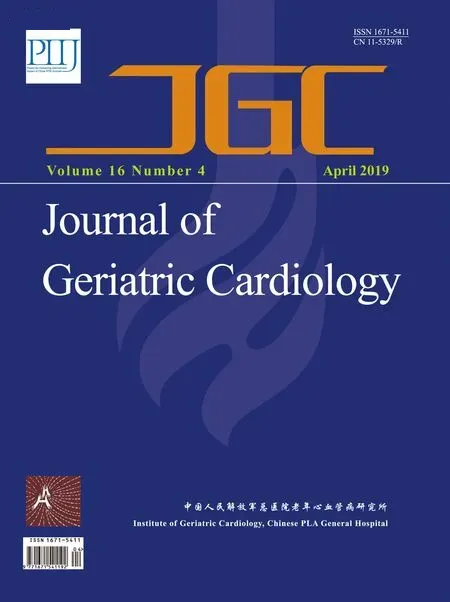Pacemaker lead induced cardiac perforation presenting with pneumothorax
Yeo-Jeong Song, Sang-Hoon Seol, Yun-Seok Song, Seunghwan Kim, Dong-Kie Kim, Ki-Hun Kim,Doo-Il Kim
Department of Internal Medicine, Inje University College of Medicine, Haeundae Paik Hospital, Busan, South Korea
Keywords: Cardiac perforation; Lead; Pneumothorax
An 87-year-old male with old myocardial infarction was referred to the hospital due to left femur neck fracture and intermittent dizziness. Significant 2:1 atrioventricular block was demonstrated on initial electrocardiogram (Figure 1).Transthoracic echocardiography showed reduced left ventricular function (LVEF = 47%) with regional wall motion abnormality of right coronary artery (RCA) and left circumflex coronary artery (LCx) artery. Coronary angiography showed patent previous proximal RCA and distal LCx stents. Temporary pacemaker was inserted initially and the patient was planned for permanent pacemaker insertion after the surgery. Dual chamber permanent pacemaker (Assurity MRITM2272, St Jude Medical, St. Paul, MN, USA) implantation was performed using screw-in lead which was actively fixed in right atrial (RA) free wall via left axillary vein under fluoroscopic guidance. Chest X-ray after implantation showed no acute complication (Figure 2A);however, follow-up chest X-ray taken after 3 days from the implantation demonstrated right pneumothorax with protrusion of RA lead at right side of cardiac silhouette (Figure 2B). Chest computed tomography was conducted for confirmation which showed broad right lung pneumothorax with penetration of RA lead screw through RA wall (Figure 3). Right chest tube insertion was performed urgently and RA lead reposition was done in RA appendage the next day(Figure 4). Nevertheless, the patient expired due to intractable septic shock and progression of acute kidney injury.

Figure 1. Initial electrocardiogram demonstrated 2:1 atrioventricular block.

Figure 2. Chest X-ray obtained after pacemaker implantation (A) and follow-up chest X-ray showed broad right pneumothorax (B)with focal atrial lead perforation (arrow).

Figure 3. Chest computed tomography revealed large right pneumothorax combined with penetration of right atrium by the atrial lead screw (arrow).

Figure 4. Fluoroscopy (PA view) obtained after initial pacemaker implantation (A), the atrial lead is located in the free wall of right atrium. Fluoroscopy (PA view) taken after the reposition of atrial lead (B), the atrial lead is relocated in right atrial appendage. PA:posteroanterior.
Acute complications from pacemaker insertion occur variously in a percentage of 3.2% to 7.5%.[1]Beyond all types of complication, cardiac perforation requiring invasive strategy is relatively rare ranging from 0.3% to 1.2%.[1]It can cause symptoms of chest pain, dyspnea, shock, death caused by iatrogenic pericarditis or tamponade; however,asymptomatic cardiac perforations detected by follow-up chest X-ray presenting pneumothorax are more common than symptomatic cardiac perforations.[1,2]The variables of pacing and sensing may show normal ranges mostly; therefore, it is difficult to aware complications from electrocardiogram. The risk factors of cardiac perforation are known as active-fixation with over-screwing of the lead, sudden removal of lead with extended screw, aggressive stylet insertion, and dislocation of atrial lead during the insertion of ventricular lead.[3]The interventionists must be always aware of the acute complications while screwing the device leads in thin atrial free wall and also should monitor for delayed complications.
Acknowledgments
The authors had no conflicts of interest to disclose.
 Journal of Geriatric Cardiology2019年4期
Journal of Geriatric Cardiology2019年4期
- Journal of Geriatric Cardiology的其它文章
- Two cases of intercoronary communication between circumflex artery and right coronary artery
- A rare case of non-ST-segment elevation myocardial infarction triggered by coronary subclavian steal syndrome
- Discrimination of ventricular tachycardia and localization of its exit site using surface electrocardiography
- Twenty-four-hour ambulatory blood pressure changes in older patients with essential hypertension receiving monotherapy or dual combination antihypertensive drug therapy
- The rate of patients at high risk for cardiovascular disease with an optimal low-density cholesterol level: a multicenter study from Thailand
- Long-term outcome of patients with atrial myxoma after surgical intervention:analysis of 403 cases
